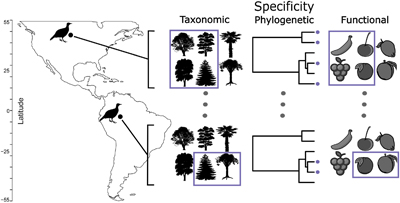Mutualistic interactions between species are key drivers of population and community dynamics. For example, seed dispersal mediated by animals influences the abundance and the distribution of the interacting species, which allows both plants and frugivores to persist across different geographic areas. Although it is known that plant–frugivore interactions are affected by the species richness, and the functional and phylogenetic diversity of the interacting species, it is still poorly understood how plant–frugivore interactions change across geographic space. In general, plant–frugivore interactions tend to be more specialized in temperate regions than in the tropics, but it is still unclear whether the specificity of these interactions also changes latitudinally.
Species interactions have been proposed to be more specialized in the tropics, although contrasting latitudinal patterns in interaction specialization have been observed for different taxa. Latitudinal changes in the specificity of plant–frugivore interactions are likely to occur because of different factors. The broader functional resource diversity in the tropics might favour generalist species to evolve traits that allow them to use the different resources available in these areas, which would lead plant–frugivore interactions to be less specific in the tropics. Alternatively, the higher climatic stability of the tropical region might allow species to potentially evolve narrower niches and specialize in specific resources that are constantly available in these areas. Latitudinal differences in the accessibility and nutritional composition of fruits could also be important drivers of differences in the specificity of plant–frugivore interactions across latitudes as these factors play an important role in promoting specialization or generalism in frugivores.

In their new study titled "Latitudinal specificity of plant–avian frugivore interactions", graduate student Cleber Ten Caten and his mentor Dr. Tad Dallas used a global data set of interactions between plants and frugivores to explore the prediction that these interactions should be more taxonomically, phylogenetically and functionally specific at lower latitudes because of the continuous availability of resources in these areas. They evaluated the consistency of these relationships considering a population, species and community context, and used a null model to determine whether the observed specificity of plant–frugivore interactions is higher or lower given what is expected due to latitudinal changes in species richness. They often observed significant relationships between latitude and interaction specificity, but these relationships were quite weak, challenging the expectation that there is a latitudinal trend in the specificity of species interactions. These results were consistent across populations, species and communities, suggesting that there are no latitudinal differences in the level of taxonomic, functional and phylogenetic constraints that could be affecting plant–frugivore interactions.